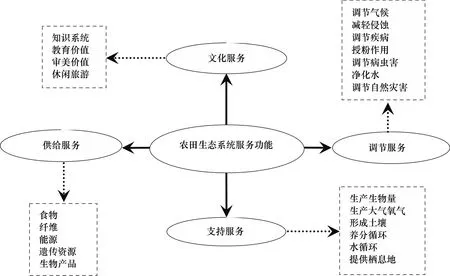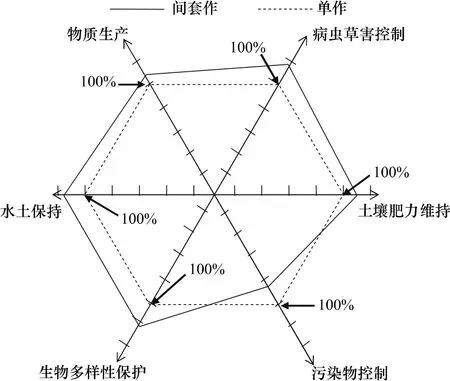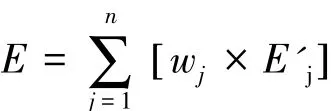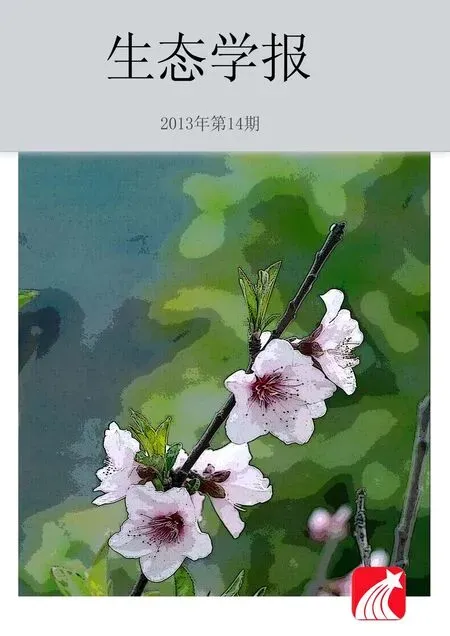间套作种植提升农田生态系统服务功能
2013-12-21苏本营陈圣宾李永庚杨文钰
苏本营,陈圣宾,李永庚,杨文钰,*
(1.四川农业大学农业部西南作物生理生态与耕作重点实验室,成都 611130;2.环境保护部南京环境科学研究所,南京 210042;3.中国科学院植物研究所植被与环境变化国家重点实验室,北京 100093)
农田生态系统是在人类干预和控制下形成的人工生态系统,具有多种经济、社会和生态功能[1,2]。农业的集约化、单一化种植,虽然显著提升了我国粮食产量,并创造了利用世界5%的土地养活世界22%人口的奇迹,却严重制约了农田其他重要生态服务功能的发挥[3-5]。在全球环境变化的大背景下,提升农田生态系统服务功能,探索低投入、高能效利用和能够自我维持的可持续农业发展模式倍受关注[6-7]。间套作是指在同一块土地上同时种植两种或两种以上作物的一种种植模式。据统计,全球间套作农田面积在1×109hm2以上,约占耕地面积的3%[8-9],在没有扩大土地面积的前提下提高了粮食产量,为解决世界人口的温饱问题做出了重要贡献。常见的间套作模式主要包括带状间作和套作两种,其中,带状间作是指在同一块田地上的不同行,同时种植两种或两种以上的作物,该模式能够充分地利用有限的土地资源[8];而套作则是指当一种作物生长到一定阶段(通常是快要成熟时),在其行间播种另一种或几种作物,从而能够充分利用光热资源,增加复种指数,提高粮产量[9]。
研究表明,间套作种植能够有效提高资源利用率和粮食产量[10-12],增强农业系统的抗风险能力[13],增加水土保持能力[14],提高土壤肥力[15],同时能够抑制病虫草害的发生[16-18],是生态农业与可持续农业发展的主要方向之一[1,18]。然而,从生态系统服务角度论述间套作农田生态系统功能的报道国内外却较为少见。本文结合国内外已有相关研究,(1)从系统物质生产、土壤肥力维持、生物多样性保护、水土保持、病虫草害和有害污染物控制等方面综述间套作种植对农田生态系统服务功能提升的贡献和作用,(2)提出了农田多生态系统服务功能的间套作评价指标和分析框架,旨在为实现农业可持续发展和更好地发挥农田生态系统服务功能提供理论依据 (图 1)[19]。
1 提升农田生态系统物质产品产出
很多研究表明,与单一种植农田相比,间套种植模式下,通过共生作物在时间和空间上的合理搭配,农田生态系统能有效提高资源利用率和单位面积粮食产出[16,20-23]。据报道,与玉米单一种植相比,玉米和大豆间套作可以提高光能的截获,降低水分的蒸发,保持土壤含水量[23],同时,通过调节大豆的密度和布局,还能够增加玉米的产量[24]。如 Li等研究发现,玉米与蚕豆或小麦间作,增施有限的磷肥即可促进玉米增产25% —40%[8]。

图1 农业生态系统的服务功能涵义[19]Fig.1 Values of agro-ecosystem services[19]
以往的研究主要通过土地当量比,对间套种植提高资源利用效率,提升生产服务功能进行评价[20-23]。土地当量比可以表示为[10]:

式中,LER表示土地当量比;Yji表示j作物在间套作农田中的单位面积产量;Yjs表示j作物在单一栽培农田中的单位面积产量;i表示间套作模式,s表示单一种植模式。当土地当量比大于1时,则表示间套作农田比单一栽培农田生产率高;相反土地当量比小于1则表明比单一栽培农田生产率低[10]。绝大多数的研究表明合理的间作套种土地当量比均大于1,表明间套作种植能够提升农田生态系统生产功能。根据现有的报道,LER大多在1.02—1.82之间,但也有报道称,不合理的间套作土地当量比则会小于1(表1)。
间套作种植模式的增产作用首先可通过种内和种间关系进行解释,作物在生长空间和时间上的差异和互补,使作物更充分地利用和吸收光照、水分和养分等生长所必须的资源,并转化成自身的光合物质[22]。已有报道,间套种植由于作物对光照的竞争而形成适宜其光截获的冠层结构[25-26];由于对地下水分和营养的竞争,导致两作物根系的分布呈明显的“偏态”不均衡分布[27],共生物种根系的差异性分布从而形成了适宜吸收营养元素和水分的独特根系分布群[28-29]。但也有报道称,不合理的间套作会造成共生作物对资源的竞争加剧,从而降低作物单位面积的物质产出[30]。合理的时间、空间和物种搭配是间套作农田生态系统物质产出服务功能提升的前提。
2 改善农田生态系统环境条件
许多研究表明,间套作种植在改善农田生态系统环境方面具有重要的意义,主要表现为:通过提高养分的利用效率和改善土壤质地,减少化学肥料投入;通过减少病虫草害的发生,降低除草剂、杀虫剂和杀菌剂的应用;此外,间套作种植还能够在控制有害重金属和有机污染物方面发挥重要作用。
2.1 维持土壤肥力,提高养分利用效率
间套作种植能够提高作物对养分的吸收和利用效率。小麦与玉米间套种植可提高小麦对N、P和K的吸收和利用,从而可使小麦产量提升40%—70%[43]。间套作种植提高养分吸收利用率主要表现在以下几个方面:1)改善农田土壤物理性状,促进植物根系发育,如Latif等对豆科植物和玉米间套作的研究表明,豆科植物的引入能够降低土壤容重和通透阻力,促进间套作系统根系的生长发育[28]。2)改善土壤化学性质[44],提高微生物活性和土壤有效氮含量[45],改变农田生态系统土壤的 N、P等营养元素在土壤中的转化和转移[43,46-47],从而提高肥料的吸收和利用效率。3)豆类植物根系分泌物还可以酸化根际土壤,促进难溶性土壤磷的活化及玉米对磷的吸收利用[8]。4)间套作农田土壤氮素的淋溶和挥发等流失会适当的降低[43,48],这也能够使土壤系统内更多的氮素被有效利用。5)豆科植物与固氮微生物形成根瘤共生体进行固氮作用也能够有效提高系统内的氮素含量[45]。

表1 不同间套作种植土地当量比[10,22,30-42]Table 1 Land Equivalent Ratio in different intercropping systems[10,22,30-42]
间套种植提高养分利用效率,维持土壤肥力的理论基础为种间作用关系理论。首先,共生物种的协作效应大于竞争效应可促进共生作物对资源的高效利用;其次,共生作物复杂的种间相互作用使土壤理化性质和微生物活性发生改变,营造了更有利于其生长发育的环境,从而引起作物对营养元素的高效吸收和利用。间套种植系统内豆科作物的固氮作用也是农田生态系统提高养分利用率和维持土壤肥力的重要途径。养分利用率的提高和土壤肥力的维持还可降低农田化学肥料的投入,从而减缓由于化肥施用所带来的环境污染,有利于资源的持续利用和农业的可持续发展。
2.2 减轻杂草和病虫害发生
间套作种植能够有效降低农田生态系统病虫草害的发生。农田生物多样性的增加,有利于生态系统的稳定性,通过系统内生物间的相互作用,使严重病虫草害爆发的可能性明显降低[4]。有研究表明,间套作农田里具有数量较高的害虫天敌,能够有效的控制害虫的数量及其对作物的危害,从而减少杀虫剂的使用[9]。如Risch对已发表的150篇大田实验结果进行总结发现,所涉及到的198种作物害虫丰富度在间套作系统的表现为:其中的53%下降,18%呈上升趋势,9%无显著变化,20%表现为不确定[49]。间套作对害虫的控制机制主要表现在两个方面(图2):首先,间套作改变了寄主植物的邻居和小气候环境,如间套作系统内部温度降低、湿度增大、光照下降将直接影响到害虫的生长发育[50]。再者,间套作增加了害虫的天敌数量,如大豆、豌豆和豇豆等豆类与玉米间作套种能够显著降低花蓟马、黑蚜、白蚁等害虫的密度及其对豆类及玉米的危害,这主要就是由间套作增加了害虫的天敌数量所引起[51]。
间套作对农田生态系统病害的发生和传播的控制也有较多的报道[16,52]。Zhu等的研究表明,易发病水稻品种与抗病性品种间作套种,则易发病水稻枯萎病发病率可下降94%,作物产量提高89%[16]。小麦与天蓝苜蓿混间作能够降低全蚀病对小麦的影响;黑麦与小麦间作或大麦与燕麦混间作都能够降低叶片真菌病菌的发生[53]。与单一栽培相比,豆类和玉米混种或行间作均能够有效的降低白叶枯病和锈病的发生,两种间套作分别能够降低白叶枯病23%和5%,锈病51%和25%[54]。Vieira等对菜豆与玉米间套种的研究也发现,间套种可以减轻叶斑病和炭疽病的发生[52]。间作套作控制病害发生主要是因为不同的病原体及有害物质有其特定的寄主,对不同遗传特征的寄主有其不同的适应性,因此多种作物混合种植能够提供多重功能,限制病原体和有害物质的迅速传播和繁殖,另外,间套作小气候环境的改变也将直接影响到作物病害的发生(图2)。
控制杂草也是间套作种植的一个重要生态效应。Abraham和Singh对高粱与豇豆间套种的研究表明,与单一种植相比,高粱和豌豆间套作能够截获更多的光资源及N、P、K营养元素从而降低了杂草的密度和干物质量[55];甘薯与玉米间套作,施肥能够显著的提高作物的叶面积指数、光截获量和营养元素的吸收量,从而抑制了杂草的生长[56];Saucke和Ackermann对豌豆和亚麻间套作的研究也表明,混间作与单作相比农田杂草盖度降低了52%—63%[17];单行或双行高粱、大豆间套作能够有效的降低香附子密度(79%—96%)和生物量(71%—97%)[57]。最近的报道表明,玉米和豆类间套作与玉米单一种植相比能够有效降低杂草丰富度,这主要是由间套作种植系统中杂草可利用光资源显著降低所引起的[58]。间套作对杂草的控制可以通过两个方面来进行解释(图2),一是与杂草竞争资源,包括对光照和养分的竞争,从而限制了杂草的生长和繁殖;二是通过作物自身的化感作用营造不利于杂草生长繁殖的环境[59]。

图2 间套作控制病虫草害示意图Fig.2 Schematic diagram of pests,diseases and weeds control of intercropping
2.3 控制有害污染物
在重金属污染农田中,通过重金属富集植物与非重金属富集作物间套种植可有效减少重金属在作物中的积累,减少对人体的危害,还可以通过非食用植物对重金属的富集降低农田中的重金属含量[60]。Gove等的报导,Zn超富集植物遏蓝菜与大麦间作,减少了大麦对Zn的吸收,同时降低了土壤中Zn的含量[61]。不同作物种植在一起会提高作物对重金属的吸收,例如豌豆和大麦间套作种植,豌豆地上部的Cu、Pb、Zn、Cd和Fe浓度是分别是单作的1.5、1.8、1.4、1.4 和1.3 倍[62];花生或鹰嘴豆与玉米、小麦间套作能加强双子叶植物对铁和锌的吸收,并提高种子中的铁、锌浓度[63]。重金属在作物中的积累将可能影响其品质,甚至危害人身健康,因此在选择间套作种植进行重金属污染土壤修复的研究中应当选择合适的植物进行搭配,所选植物种类尽可能即可提高超富集植物对重金属的吸收,又能够降低与之间作的农作物重金属含量。
间套作种植还能够促进农田生态系统有机污染物的降解,玉米、三叶草、黑麦草混作栽培能够显著提高菲和芘的降解,其中玉米与黑麦草混作效果最好,60 d后98.2%菲和95.8%芘被去除[64]。南瓜、大豆、南瓜相互间作对土壤多氯联苯降解影响的研究表明,与单作相比,间作对多氯联苯的去除率提高了1.4%—13.5%[65]。其原因可能在于间套作系统能改变根际微环境的理化性质和生物学特性,特别是能通过根系分泌物和其他根际过程,从而改变根际微生物的种类和数量,改变根际土壤酶的活性和植物生长的营养条件[8,66],最终影响了有机污染物的根际降解和植物吸收。但其具体机理还有待于深入的研究。
3 提高农田生态系统服务
水土保持和生物多样性保护是生态系统服务功能发挥的重要表现,研究表明,间套作种植可通过扩大农田地表植被覆盖和土壤根系分布减少农田水土流失的发生,可通过作物多样性的提高营造适宜更多昆虫和土壤生物生活的生境,从而保护更多的生物多样性。
3.1 水土保持服务功能提升
水土流失包括水蚀和风蚀,是指在水、重力、风等外力作用下,水土资源和土地生产力的破坏和损失[67]。农田生态系统是水土流失最为严重的生态系统类型。据统计,全球每年约有7.5×1011t肥沃土壤从农田生态系统流失[68]。因此,如何降低农田(特别是丘陵旱地)土壤侵蚀是农业发展面临的最为关键的环境问题之一,也是当前农业可持续发展面临的巨大挑战。
研究表明,与豆科植物间套作能够有效地减少地表径流,控制水土流失,保障农田生产力[9,69]。Zougmore等对高粱和豇豆间套种植的研究表明,与单一种植相比,间作套种可减少20%—55%的水土流失[70]。间套种植配合秸秆还田、作物残体覆盖,则能够更有效地减少地表径流和表层土壤流失,流失率减少达94%[71]。Ali等对豆科植物间套作与单一种植进行对比研究也发现,间套作能够降低地表径流,减少土壤、有机质和营养物质的损失,土壤流失量与有机质和营养元素的损失呈显著的正相关关系[72]。Chen等对中国北方多风区农田的研究发现,合理的小麦和土豆间作套种可有效地控制风蚀和土壤流失[73]。带状间套种植也已被该区域作为控制水土流失的有效措施[74]。间套作种植提升农田水土保持服务功能的机制在于扩大了农田地表的植被覆盖和土壤根系在土壤中的分布范围,地表植被覆盖的增加可有效地削弱风雨对土壤的冲击力,从减少土壤和营养的流失;根系分布范围的扩大能够提升根系对土壤的固持作用,从而减轻坡地土壤的水土流失。
3.2 生物多样性保护加强
生物多样性是指生命有机体及其借以生存的生态复合体的多样性和变异性,主要包括:遗传多样性、物种多样性、生态系统多样性和景观多样性[75]。农田生态系统作为人类干扰最为严重的生态系统类型,其生物多样性主要表现为种植作物及多种动物、植物和微生物的多样性[76]。在过去的几十年里,世界范围内的生物多样性丧失呈现出空前水平,农业活动是造成生物多样性丧失的一个重要驱动因素[6,77],如何通过栽培措施保持农田生态系统生物多样性面临着巨大的挑战[76]。
研究表明,通过同一作物的不同基因型搭配种植[16]或不同功能型作物间套种植[78]可有效提高农田生态系统的生物多样性。与单一栽培相比,间套作能够提高作物根际微生物的多样性[45]和土壤动物多样性[78]。Schmidt和Curry对小麦与三叶草间作农田土壤蚯蚓数量进行调查发现,间作农田土壤单位面积蚯蚓数量是单一种植土壤的3.6倍[79]。Jones和Sieving的研究表明,与单一栽培相比,间套作农田食虫鸟类显著增加,有利于控制农田虫害的发生[80]。另外,作物间作套种也能够提高传粉昆虫多样性的增加,提高作物授粉比率,从而有利于作物产量的形成[81]。间套种植保护生物多样性的机制在于作物多样性的提高营造了适宜更多昆虫和土壤生物生活的生境[78],直接促进了生物多样性的提升。另外,土壤肥力自我调节的加强[45],营养物质流失的降低[47]及有害物质(杀虫剂和除草剂)的降低[16,82]间接地提升了农田生物多样性,农田生态系统生物多样性的提高,对于生物多样性保护具有重要意义。
4 农田生态系统多服务功能的间套作评价理论框架及指标
4.1 理论框架的构建
在综述间套作对农田生态系统服务功能的提升和贡献的基础上,构建了农田生态系统多服务功能的间套作评价指标体系及理论框架。生态系统服务功能评价指标主要涉及物质生产、土壤肥力维持、病虫害控制、生物多样性保护、水土保持和有害污染物控制等6个。对间套作农田生态系统进行多服务功能评价时,首先将单作时的各个生态系统服务功能都标准化为100%,与之相比,间套作时的生态系统服务功或高于100%或低于100%(图3)。
4.2 间套作农田生态系统服务功能的量化与标准化
参考土地当量比的方法,设计了各个生态系统服务功能在间套作和单作间的比较方法。具体量化方法为:(1)物质生产功能的量化值以土地当量比(LER)进行表示[10];(2)土壤肥力维持和生物多样性保护功能的量化值分别以间套作土壤可利用营养元素含量和农田生物多样性指数与相应作物净作土壤的可利用营养元素和生物多样性指数比值的平均值表示[45,78]。具体公式可表示为:


图3 农田生态系统服务功能的间套作评价理论框架Fig.3 Theoretical framework to evaluate the ecosystem services of intercropping cropland
式中,E'为某一功能的量化值,n为间套物种数;Min分别为间套作农田土壤可利用营养元素含量和生物多样性指数;Mj为j作物净作农田土壤可利用营养元素和生物多样性指数。
(3)病虫草害控制、水土保持和有害污染物控制的量化值则以间套作农田病虫草害、水土流失和有害物质发生降低的比率加 1 进行表示[9,16,55,65,70],具体公式为:

式中,E'为某一功能的量化值,Min为间套作农田病虫草害、水土流失和有害污染物发生的量;Mj为相应j作物净作农田病虫草害、水土流失和有害物质发生的量。
将已进行量化的各服务功能结合其功能权重的大小进行标准化,最终得出间套作农田生态系统多服务功能的综合评价指数。综合评价指数的公式可表示为:

其中E是综合评价指标;E'j是间套作农田第j功能的值;n是功能的个数;wj,是第j功能的权重,取值范围为(0,1),且n个权重之和为1,权重的值越大则认为这个功能相对越重要。权重的值采用经验法或调查统计法确定。
5 结束语
研究表明,到2030年我国人口将达到16亿,这意味着我国粮食年增长率要稳定在580Mt左右[5],才能满足国家和人民的需求。然而在全球气候变化[83]、土地、水、营养等资源匮乏[6]、环境污染加剧[3]的影响下,粮食增产将面临着巨大的挑战[7]。如何在这种形式下,提高农业资源利用率和土地产出率实现粮食增产,是科学家和政府共同关注的焦点问题。间套作农田生态系统不但具有为人类的生存与发展提供坚实物质基础和食物保障的产品服务功能,还具有巨大的环境服务功能价值和生态安全价值[1],能够在解决世界粮食安全和农业可持续发展等方面做出一定的贡献。
随着全球变化加剧、生物多样性丧失、环境污染严重及农田土壤肥力下降等一系列生态环境问题的出现,间套作种植在温室气体调节、碳固持和水循环调节等生态系统服务方面的研究及套作农田生态系统可持续发展及其对全球变化响应方面的研究都有待加强。
[1]Power A G.Ecosystem services and agriculture:tradeoffs and synergies.Philosophical Transactions of the Royal Society B:Biological Sciences,2010,365(1554):2959-2971.
[2]Swinton SM,Lupia F,Robertson G P,Hamilton SK.Ecosystem services and agriculture:cultivating agricultural ecosystems for diverse benefits.Ecological Economics,2007,64(2):245-252.
[3]Guo JH,Liu X J,Zhang Y,Shen JL,Han WX,Zhang WF,Christie P,Goulding K WT,Vitousek P M,Zhang F S.Significant acidification in major Chinese croplands.Science,2010,327(5968):1008-1010.
[4]Altieri M A.The ecological role of biodiversity in agroecosystems.Agriculture,Ecosystems and Environment,1999,74(1/3):19-31.
[5]Fan M S,Shen JB,Yuan L X,Jiang R F,Chen X P,Davies WJ,Zhang F S.Improving crop productivity and resource use efficiency to ensure food security and environmental quality in China.Journal of Experimental Botany,2012,63(1):13-24.
[6]Tilman D,Cassman K G,Matson P A,Naylor R,Polasky S.Agricultural sustainability and intensive production practices.Nature,2002,418(6898):671-677.
[7]Godfray H C J,Beddington J R,Crute I R,Haddad L,Lawrence D,Muir J F,Pretty J,Robinson S,Thomas SM,Toulmin C.Food security:the challenge of feeding 9 billion people.Science,2010,327(5967):812-818.
[8]Li L,Li SM,Sun J H,Zhou L L,Bao X G,Zhang H G,Zhang F S.Diversity enhances agricultural productivity via rhizosphere phosphorus facilitation on phosphorus-deficient soils.Proceedings of the National Academy of Sciences of the United States of America,2007,104(27):11192-11196.
[9]Lithourgidis A S,Dordas CA,Damalas CA,Vlachostergios D N.Annual intercrops:an alternative pathway for sustainable agriculture.Australian Journal of Crop Science,2011,5(4):396-410.
[10]Agegnehu G,Ghizaw A,Sinebo W.Yield potential and land-use efficiency of wheat and faba bean mixed intercropping.Agronomy Sustain Development,2008,28(2):257-263.
[11]Metwally A A,Shafik M M,EI-Habbak K E,Abdel-Wahab SI.Yield and land equivalent ratio of intercropped soybean with maize under different intercropping patterns and high population densities.Egyptian Journal of Agronomy,2009,31(2):199-222.
[12]Pypers P,Sanginga JM,Kasereka B,Walangululu M,Vanlauwe B.Increased productivity through integrated soil fertility management in cassavalegume intercropping systems in the highlands of Sud-Kivu,DR Congo.Field Crops Research,2011,120(1):76-85.
[13]Horwith B.A role for intercropping in modern agriculture.BioScience,1985,35(5):286-291.
[14]Leihner D E,Ruppenthal M,Hilger T H,Castillo J A F.Soil conservation effectiveness and crop productivity of forage legume intercropping,contour grass barriers and contour ridging in cassava on Andean Hillsides.Experimental Agriculture,1996,32(3):327-338.
[15]Fustec J,Lesuffleur F,Mahieu S,Cliquet JB.Nitrogen rhizodeposition of legumes.Agriculture Sustainable,2010,3(1):869-881.
[16] Zhu Y Y,Chen H R,Fan JH,Wang Y Y,Li Y,Chen JB,Fang JX,Yang SS,Hu L P,Leung H,Mew T W,Teng P S,Wang Z H,Mundt C C.Genetic diversity and disease control in rice.Nature,2000,406(6797):718-722.
[17]Saucke H,Ackermann K.Weed suppression in mixed cropped grain peas and false flax(Camelina sativa).Weed Research,2006,46(6):453-461.
[18]Shennan C.Biotic interactions,ecological knowledge and agriculture.Philosophical Transactions of the Royal Society B:Biological Sciences,2008,363(1492):717-739.
[19]Millennium Ecosystem Assessment.Ecosystems and Human Well-Being:Synthesis.Washington,D C:Island Press,2005.
[20]James R A,Robert K O.Yield of corn,cowpea,and soybean under different intercropping systems.Crop Science Society of America,1982,75(6):1005-1009.
[21]Ghanbari A,Dahmardeh M,Siahsar B A,Ramroudi M.Effect of maize(Zea mays L.)-cowpea(Vigna unguiculata L.)intercropping on light distribution,soil temperature and soil moisture in and environment.International Journal of Food,Agriculture and Environment,2010,8(1):102-108.
[22]Echarte L,Maggiora A D,Cerrudo D,Gonzalez V H,Abbate P,Cerrudo A,Sadras V O,Calvino P.Yield response to plant density of maize and sunflower intercropped with soybean.Field Crops Research,2011,121(3):423-429.
[23]Undie U L,Uwah D F,Attoe E E.Effect of intercropping and crop arrangement on yield and productivity of late season maize/soybean mixtures in the humid environment of South Southern Nigeria.Journal of Agricultural Science,2012,4(4):37-51.
[24]Waddington SR,Mekuria M,Siziba S,Karigwindi J.Long-term yield sustainability and financial returns from grain legume-maize intercrops on a sandy soil in subhumid north central Zimbabwe.Experimental Agriculture,2007,43(4):489-503.
[25]Gao Y,Duan A W,Qiu X Q,Sun JS,Zhang JP,Liu H,Wang H Z.Distribution and use efficiency of photosynthetically active radiation in strip intercropping of maize and soybean.Agronomy Journal,2010,102(4):1149-1157.
[26]He H M,Yang L,Fan L M,Zhao L H,Wu H,Yang J,Li CY.The effect of intercropping of maize and soybean on microclimate.Computer and Computing Technologies in Agriculture,2012,369:257-263.
[27]Zhang E H,Huang G B.Temporal and spatial distribution characteristics of the crop root in intercropping system.Chinese Journal of Applied Ecology,2003,14(8):1301-1304.
[28]Gao Y,Duan A W,Qiu X Q,Liu Z G,Sun J S,Zhang J P,Wang H Z.Distribution of roots and root length density in a maize/soybean strip intercropping system.Agricultural Water Management,2010,98(1):100-212.
[29]Zhang H B,Ren W J,Yang W Y,Wu X Y,Wang Z,Yang J Z.Effect of different nitrogen levels on morphological and physiological characteristics of relay-planting soybean root.Acta Agronomica Science,2007,33(1):107-112.
[30]Fan F L,Zhang F S,Song Y N,Sun JH,Bao X G,Guo TW,Li L.Nitrogen fixation of faba bean(Vicia faba L.)interacting with a non-legume in two contrasting intercropping systems.Plant and Soil,2006,283(1/2):275-286.
[31]LI Q Z,Sun J H,Wei X J,Christie P,Zhang F S,Li L.Overyielding and interspecific interactions mediated by nitrogen fertilization in strip intercropping of maize with faba bean,wheat and barley.Plant and Soil,2011,339(1/2):147-161.
[32]Zhang G G,Yang Z B,Dong ST.Interspecific competitiveness affects the total biomass yield in an alfalfa and corn intercropping system.Field Crops Research,2011,124(1):66-73.
[33]Vishwanatha S,Koppalkar B G,Anilkumar SN,Desai B K,Naik V.Economics and yield advantages of pigeonpea and sunflower intercropping system influenced by fertilizer management.Research Journal of Agricultural Sciences,2011,2(3):248-251.
[34]Mason SC,Leihner D E,Vorst J J.Cassava-cowpea and cassava-peanut intercropping.Ⅰ.Yield and land use efficiency.Agronomy Journal,1984,78(1):43-46.
[35]Carruthers K,Prithiviraj B,Fe Q,Cloutier D,Martin R C,Smith D L.Intercropping corn with soybean,lupin and forages:yield component responses.European Journal of Agronomy,2000,12(2):103-115.
[36]Liu Y H,Zhang L F.Quantitative evaluation of land use efficiency under different cropping patterns.Scientia Agricultura Sinica,2006,39(1):57-60.
[37]Banik P,Midya A,Sarkar B K,Ghose S S.Wheat and chickpea intercropping systems in an additive series experiment:Advantages and weed smothering.European Journal of Agronomy,2006,24(4):325-332.
[38]Caviglia OP,Sadras V O,Andrade F A.Yield and quality of wheat and soybean in sole-and double-cropping.Agronomy Journal,2011,103(4):1081-1089.
[39]Sarlak S,Aghaalikhani M,Zand B.Effect of plant density and mixing ratio on crop yield in sweet corn/mungbean intercropping.Pakistan Journal of Biological Sciences,2008,11(17):2128-2133.
[40]Hauggaard-Nielsen H,Gooding M,Ambus P,Gorre-Hellou G,Crozat Y,Dahlmann C,Dibet A,von Fragstein P,Pristeri A,Monti M,Jensen E S.Pea-barley intercropping for efficient symbiotic N2-fixation,soil N acquisition and use of other nutrients in European organic cropping systems.Field Crops Research,2009,113(1):64-71.
[41]Ghosh P K.Growth,yield,competition and economics of groundnut/cereal fodder intercropping systems in the semi-arid tropics of India.Field Crops Research,2004,88(2/3):227-237.
[42]Gao Y,Duan A W,Sun J S,Li F S,Liu Z G,Liu H,Liu Z D.Crop coefficient and water-use efficiency of winter wheat/spring maize strip intercropping.Field Crops Research,2009,111(1/2):65-73.
[43]Li L,Sun J H,Zhang F S.Intercropping with wheat leads to greater root weight density and larger below-ground space of irrigated maize at late growth stages.Soil Science and Plant Nutrition,2011,57(1):61-67.
[44]Song Y N,Zhang F S,Marschner P,Fan F L,Gao H M,Bao X G,Sun H J,Li L.Effect of intercropping on crop yield and chemical and microbiological properties in rhizosphere of wheat(Triticum aestivum L.),maize(Zea mays L.),and faba bean(Vicia faba L.).Biology and Fertility of Soils,2007,43(5):565-574.
[45]Singha N B,Singha P P,Naira K P P.Effect of legume intercropping on enrichment of soil Nitrogen,bacterial activity and productivity of associated maize crops.Experimental Agriculture,1986,22(4):339-344.
[46]Kolawolea G O.Effect of phosphorus fertilizer application on the performance of maize/soybean intercrop in the southern Guinea savanna of Nigeria.Archives of Agronomy and Soil Science,2012,58(2):189-198.
[47]Yong T W,Yang W Y,Xiang D B,Wan Y,Liu W G,Wang X C.Effect of Wheat/Maize/Soybean and Wheat/Maize/Sweet potato relay strip intercropping on soil nitrogen content and nitrogen transfer.Acta Agronomica Science,2012,38(1):148-158.
[48]Oelbermann M,Echarte L.Evaluating soil carbon and nitrogen dynamics in recently established maize-soybean inter-cropping systems.European Journal of Soil Science,2011,62(1):35-41.
[49]Risch SJ.Intercropping as cultural pest control:prospects and limitations.Environmental Management,1983,7(1):9-14.
[50]Langer V,Kinane J,Lyngkaer M.Intercropping for pest management:the ecological concept//Koul O,Cuperus G W,eds.Ecologically Based Integrated Pest Management.Wallingford:CAB International,2007:74-110.
[51]Kyamanywa S,Ampofo JK O.Effect of cowpea/maize mixed cropping on the incident light at the cowpea canopy and flower thrips(Thysanoptera:Thripidae)population density.Crop Protection,1988,7(3):186-189.
[52]Vieira R F,de Paula Júnior T J,Teixeira H,Vieira C.Intensity of angular leaf spot and anthracnose on pods of common beans cultivated in three cropping systems.Ciência E Agrotecnologia,2009,33(S1):1931-1934.
[53]Vilich-Meller V.Mixed cropping of cereals to suppress plant diseases and omit pesticide applications.Biological Agriculture and Horticulture,1992,8(4):299-308.
[54]Fininsa C.Effect of intercropping bean with maize on bean common bacterial blight and rust diseases.International Journal of Pest Management,1996,42(1):51-54.
[55]Abraham C T,Singh S P.Weed management in sorghum-legume intercropping systems.The Journal of Agricultural Science,1984,103(1):103-115.
[56]Olasantan F O,Lucas E O,Ezumah H C.Effects of intercropping and fertilizer application on weed control and performance of cassava and maize.Field Crops Research,1994,39(2/3):63-69.
[57]Iqbal J,Cheema Z A,An M.Intercropping of field crops in cotton for the management of purple nutsedge(Cyperusrotundus L.).Plant and Soil,2007,300(1/2):163-171.
[58]Bilalis D,Papastylianou P,Konstantas A,Patsiali S,Karkanis A,Efthimiadou A.Weed-suppressive effects of maize-legume intercropping in organic farming.International Journal of Pest Management,2010,56(2):173-181.
[59]Olorunmaiye P M.Weed control potential of five legume cover crops in maize/cassava intercrop in a Southern Guinea savanna ecosystem of Nigeria.Australian Journal of Crop Science,2010,4(5):324-329.
[60]Wei Z B,Guo X F,Qiu J R,Chen X,Wu Q T.Innovative technologies for soil remediation:intercropping or co-cropping.Journal of Agro-Environment Science,2010,29(S1):267-272.
[61]Gove B,Hutchinsona J J,Younga SD,Craigonb J,McGrathc SP.Uptake of Metals by Plants Sharing a Rhizosphere with the Hyperaccumulator Thlaspi caerulescens.International Journal of Phytoremediation,2002,4(4):267-281.
[62]Luo C L,Shen Z G,Li X D.Root exudates increase metal accumulation in mixed cultures:Implications for naturally enhanced phytoextraction.Water,Air and Soil Pollution,2008,193(1/4):147-154.
[63]Zuo Y,Zhang F.Iron and zinc biofortification strategies in dicot plants by intercropping with gramineous species:a review.Agronomy for Stainable Development,2009,29(1):63-71.
[64]Xu SY,Chen Y X,Wu W X,Wang K X,Lin Q,Liang X Q.Enhanced dissipation of phenanthrene and pyrene in spiked soils by combined plants cultivation.Science of the Total Environment,2006,363(1/3):206-215.
[65]Zhuo S,He H Z,Li H S,Qin ZX,Wen X Y,Li Y J.Effects of Rhizo-remediation polychlorinated biphenyl contaminated soil under intercropping system.Journal of Agro-Environment Science,2010,29(1):73-77.
[66]Li L,LIX L,Zhang F S.Facilitation of wheat to phosphorus uptake by soybean in the wheat-soybean intercropping.Acta Ecologica Sinica,2000,20(4):629-633.
[67]Van Oost K,Quine TA Govers G,De Gryze S,Six J,Harden JW,Ritchie JC,McCarty GW,Heckrath Kosmas GC,Giraldez JV,Marques da Silva JR,Merckx R.The impact of agricultural soil erosion on the global carbon cycle.Science,2007,318(5850):626-629.
[68]Montgomery D R.Soil erosion and agricultural sustainability.Proceedings of the National Academy of Sciences of the United States of America,2007,104(33):13268-13272.
[69]Xiang D B,Yong T W,Yang W Y,Yu X B,Guo K.Effects of planting system on soil and water conservation and crop output value in a sloping land of Southwest China.Chinese Journal of Applied Ecology,2010,21(6):1461-1467.
[70]Zougmore R,Kambou F N,Ouattara K,Guillobez S.Sorghum-cowpea intercropping:an effective technique against runoff and soil erosion in the Sahel(Saria,Burkina Faso).Arid Soil Research and Rehabilitation,2000,14(4):329-342.
[71]Wall G J,Pringle E A,Sheard R W.Intercropping red clover with silage corn for soil erosion control.Canadian Journal of Soil Science,1991,71(2):137-145.
[72]Ali I,Khan F,Bhatti A U.Soil and nutrient losses by water erosion under mono-cropping and legume inter-cropping on sloping land.Pakistan Journal of Agricultural Research,2007,20(3/4):161-166.
[73]Chen Z,Cui H M,Wu P,Zhao Y L,Sun Y C.Study on the optimal intercropping width to control wind erosion in North China.Soil and Tillage Research,2010,110(2):230-235.
[74]Liu X B,Zhang SL,Zhang X Y,Ding G W,Cruse R M.Soil erosion control practices in Northeast China:a mini-review.Soil and Tillage Research,2011,117:44-48.
[75]Ma K P.Discuss the concept of biodiversity.Chinese Biodiversity,1993,1(1):20-22.
[76]Butler SJ,Vickery J A,Norris K.Farmland biodiversity and the footprint of agriculture.Science,2007,315(5810):381-384.
[77]Tilman D,Fargione J,Wolff B,D'Antonio C,Howarth R,Schindler D,Swackhamer D.Forecasting agriculturally driven global environmental change.Science,2001,292(5515):281-284.
[78]Rothwell A,Chaney K,Haydock P.The impact of cultivation techniques on earthworm populations.Soil Biology,2011,24:159-172.
[79]Schmidt O,Curry J P.Population dynamics of earthworms(Lumbricidae)and their role in nitrogen turnover in wheat and wheat clover cropping systems.Pedobiologia,2001,45(2):174-187.
[80]Jones G A,Sieving K E.Intercropping sunflower in organic vegetables to augment bird predators of arthropods.Agriculture,Ecosystems and Environment,2006,117(2/3):171-177.
[81]Frimpong E A,Gemmill-Herren B,Gordon I,Kwapong P K.Dynamics of insect pollinators as influence by cocoa production systems in Ghana.Journal of Pollination Ecology,2011,5(10):74-80.
[82]Bannon F J,Cooke B M.Studies on dispersal of Septoria tritici pycnidiospores in wheat-clover intercrops.Plant Pathology,1998,47(1):49-56.
[83]Schmidhuber J,Tubiello F N.Global food security under climate change.Proceedings of the National Academy of Sciences of the United States of America,2007,104(50):19703-19708.
参考文献:
[27]张恩和,黄高宝.间套种植复合群体根系时空分布特征.应用生态学报,2003,14(8):1301-1304.
[29]张含彬,任万军,杨文钰,伍晓燕,王竹,杨继芝.不同施氮量对套作大豆根系形态与生理特性的影响.作物学报,2007,33(1):107-112.
[36]刘玉华,张立峰.不同种植方式土地利用效率的定量评价.中国农业科学,2006,39(1):57-60.
[47]雍太文,杨文钰,向达兵,万燕,刘卫国,王小春.小麦/玉米/大豆和小麦/玉米/甘薯套作对土壤氮素含量及氮素转移的影响.作物学报,2012,38(1):148-158.
[60]卫泽斌,郭晓方,丘锦荣,陈娴,吴启堂.间套作体系在污染土壤修复中的应用研究进展.农业环境科学学报,2010,29(S1):267-272.
[65]卓胜,贺鸿志,黎华寿,秦之璇,温贤有,李拥军.植物间作体系根际修复土壤多氯联苯的效应.农业环境科学学报,2010,29(1):73-77.
[66]李隆,李晓林,张福锁.小麦/大豆间作中小麦对大豆磷吸收的促进作用.生态学报,2000,20(4):629-633.
[69]向达兵,雍太文,杨文钰,于晓波,郭凯.不同种植模式对西南坡地水土保持及作物产值的影响.应用生态学报,2010,21(6):1461-1467.
[75]马克平.试论生物多样性的概念.生物多样性,1993,1(1):20-22.
